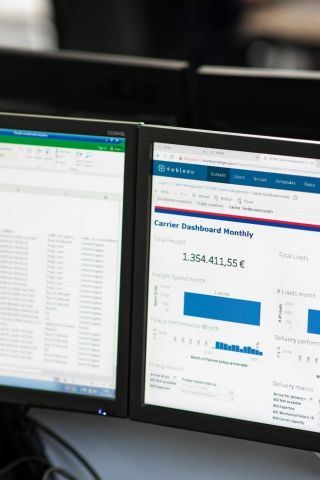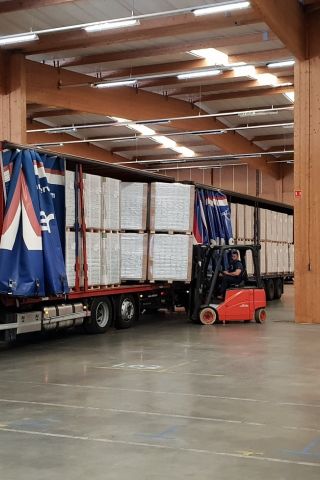How to manage order peaks and your transport capacity?
There is a transport capacity crisis, and with the coming holiday season, there will only be more pressure on logistics.
After this article, you know:
✔ How order peaks pressure capacity even further
✔ How to ensure on-time delivery while controlling your costs
✔ How to stay relaxed during the holiday season
Shortage, holidays & promotions
First published: October 28, 2021
Last updated: July 30, 2023
As a logistics manager of a manufacturing company, you are fully aware of ever shifting order patterns of your customers. Whether these are small or large changes, you will always face different order sizes. Consequently, there are times you need substantially more transport capacity, the so-called ‘order peaks.’ A year ago, this would be no problem, but in the current market, we often see the following scenario in play:
- On Thursday afternoon, your sales colleague announces a large promotion. It is for a big customer, and the delivery date is in 2 weeks’ time, all for delivery on Wednesday.
- This promotion doubles the number of orders to plan from 50 to 100.
- Your logistics buyer already has a hard job finding enough transport capacity, especially considering quality and cost KPIs.
- Therefore, it is hard to deliver the regular 50 orders on time and on budget.
- Combining this transport capacity crisis with short-noticed, fixed-date order peaks results in an even more stressed situation.
- In the end, you have to explain to your superiors why the transport costs for this promotion exceeded budgets, why you did not meet on-time performance levels and why customer service had to deal with so many complaints.
Does this sound familiar to you? Well, if it does, this article is about to help you out. First, we will set out what is happening. Then, we will offer you some knowledge to prevent this from happening, this way future customer promotions will give you a bonus instead of a headache.
How do order peaks put transport capacity under pressure?
Order peaks typically occur because of promotions, supplying extra stock for weekends, the last week of the month, or for upcoming holidays like Black Friday and Christmas.
Usually, such a peak of orders causes increased pressure on the supply chain. In a transport market with a capacity shortage, this can easily become too much pressure. Just as we saw happening in the scenario, the high pressure causes unwanted effects like increasing prices and performance risks. Not to mention the higher empty kilometers and therefore unnecessary CO2 emissions. The carrier management team at SmartWay Logistics seeks to ensure a well-balanced transport capacity.
Peaks have always been and will continue to be a part of the logistic process. However, for your customer, these peaks are mostly predictable. Promotions and seasonal changes are part of their marketing plans, which means the orders can be anticipated if you, as a shipper, communicate with the customer at an early stage. By forecasting and anticipating the peak periods, you can ensure that the logistics process runs smoothly and efficiently for both you and the customer.
Key take away
Order peaks in logistics are often predictable and manageable with good communication and information.
What can a shipper do to manage sudden order peaks?
An easy solution to better use the available capacity is to spread the peaks over a longer period. When you, as a shipper, expect to have certain peaks, try to flatten these out as much as possible. Thereby ask yourself: is it really needed for your customer to have all promotion articles in store on Wednesday, while the promotion starts the Monday thereafter? Or, could they receive some on Tuesday and the rest on Thursday?
Key take away
By spreading the volume, you can overcome order peaks, and ensure sufficient capacity while meeting performance standards for on-time delivery and cost-effectiveness.
How can you spread the order volume?
The main thing to do is contact your customer and ask if there is any problem delivering on multiple days instead of one.
We have listed a few examples in the table below.
Customers ask for: | You can propose: | Why is this a win-win? |
Promotion articles in store next Wednesday | Can we deliver on three days, like the Wednesday before and in the promotion week on Tuesday and Thursday? | Because the promotion runs one week after the requested delivery date, the customer just wanted to ensure delivery. By spreading, there is less pressure on the customers’ warehousing. |
Summer season articles are to be delivered in high volume in July | To start two weeks before July and end somewhere in August | Because during summer time there is more demand for a particular product |
Many pickups during the last week of the month | Can we pick up more loads during the third week of the month | Because sales would like the turnover to be registered in that month. |
Three instead of one day to pick up or deliver goods already makes a significant difference. Picture this: You have six full truckloads more to ship. Which will be most manageable?
- Increase your capacity from 6 trucks to 12 on a single day;
- Alternatively, you can raise the amount of trucks from 6 a day to 8 for three days.
Key take away By spreading your orders during peaks as much as possible, you have more control over your cost level and on-time performance. At the same time, you will probably spread the pressure on in-store stocks and warehousing of your customers.
What can customer service do to achieve the best results?
Customer service is often the department that receives the orders. Therefore, they play a critical role in achieving a high delivery performance. However, many are unaware of their influence, likely caused by KPIs such as ‘on-time order processing.’
They can do a few things to unnerve this pressure: If they take the stake of transport, warehousing and the customer into consideration, they can prevent the issues by discussing the delivery moments and volume with the customer and explaining the impact on performance.
What about the sales department?
Consider basic business economics: making a big deal for a good price doesn’t necessarily mean a profit. The costs are equally important. Previously, you could count on somewhat of the same low transport cost component. This has changed; low capacity and high demand can easily double your costs if you don’t anticipate. So, what has your sales colleague to do in all this? Considering the impact on transport and warehousing from the start will turn a deal into an outstanding sales hit for your colleague. In the ideal world, your sales colleague would consult you before making the deal final or at least add these two factors to the agreement:
- Orders should be sent as soon as possible
- Flexibility on delivery, for example, a time frame instead of one date
That’s the prominent part, so what can you do to get them there?
Well, it might come as a surprise, but chances are high your colleague does not really know about the impact of the capacity crises on (your) daily business. So, explain that the transport market has changed, prices have become more volatile and acquiring capacity is challenging. Then, ask them to do the previously mentioned, let them be involved or at least consult you.
Chances are high your colleague understands after you explain the impact of such deals on logistics and how easily they can help to solve it. In the end, you both have the same company goals, don’t you?
LEAVE YOUR CONTACT DETAILS AND WE WILL CONTACT YOU.
Want to know more about carrier management?
Ask about carrier management, other SmartWay Logistics services, pricing, implementation or any other concerns.
Our experts are ready to answer your questions. Or, check out our leaflet or give us a call (+31(0)30 - 82 00 800).
Our Services
Carrier management is an integrated part of the control tower functionality of SmartWay Logistics. With our in-house experts, we can give you advice on a consultancy basis or coordinate the carrier process on your behalf.






